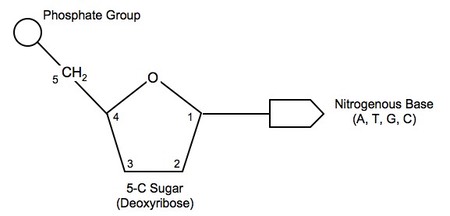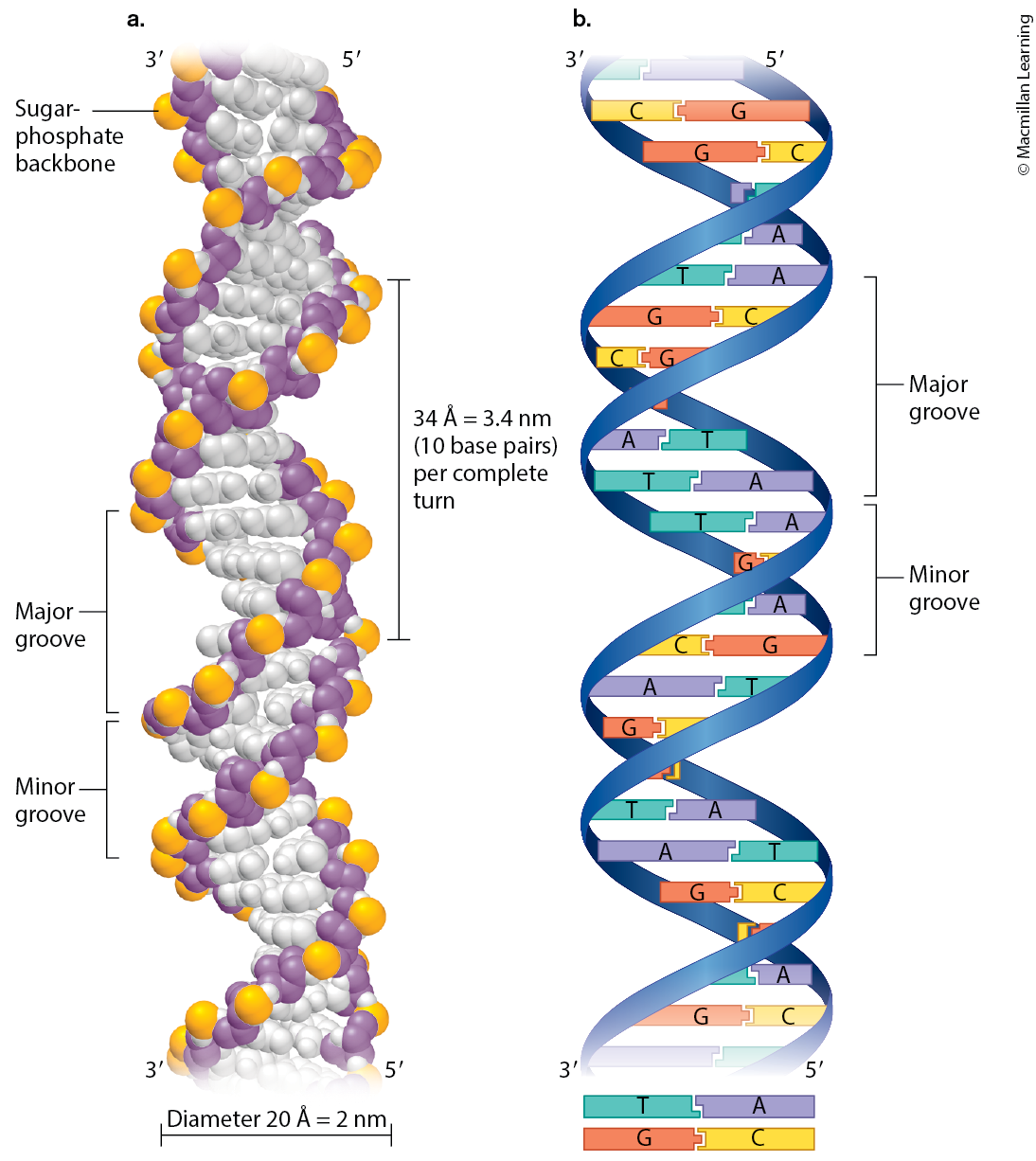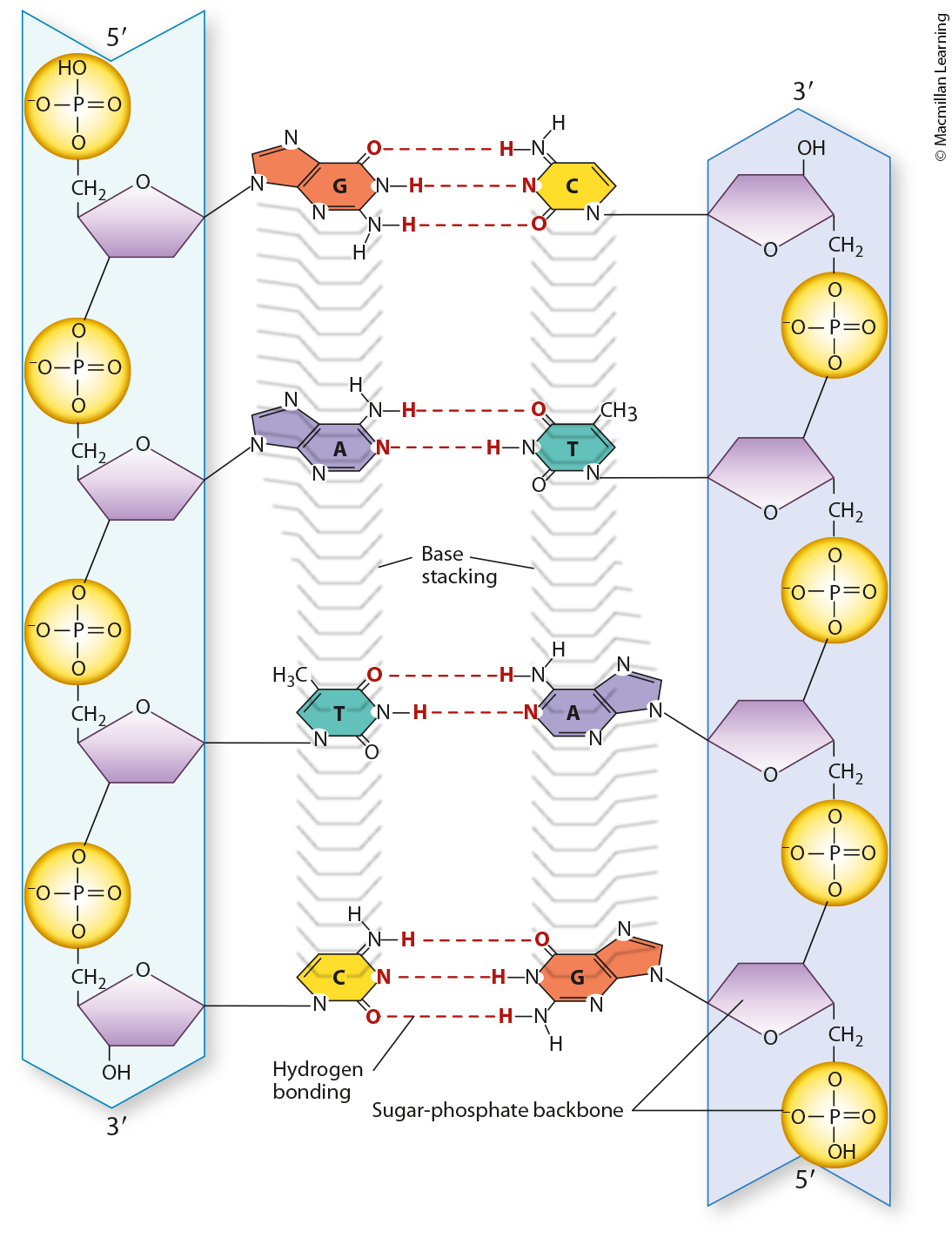MLB 111 - Study Unit 4 Learning Outcomes
1/28
There's no tags or description
Looks like no tags are added yet.
Name | Mastery | Learn | Test | Matching | Spaced |
|---|
No study sessions yet.
29 Terms
Draw & label a nucleotide.

Name the four different nucleotides in DNA.
Adenine (A), Thymine (T), Cytosine (C) & Guanine (G).
Chargaff’s Rules
Amount of A = Amount of T
Amount of C = Amount of G
Therefore, Proportion of Purines (A & G) = Proportion of Pyrimidines (C & T)
Complementary Base-Pairing
A forms 2 Hydrogen bonds with T.
G forms 3 Hydrogen bonds with C.
The role of nucleotides in the structure of the DNA helix.
Fundamental building blocks of DNA.
Form the backbone of the DNA helix through phosphodiester bonds and facilitate the double-stranded helical structure via complementary base pairing and hydrogen bonding.
Structure allows DNA to store genetic information, be accurately replicated, and transcribed into RNA for protein synthesis.
The role of phosphodiester bonds in the structure of the DNA helix.
Form the sugar-phosphate backbone, providing stability and resistance to breakage.
Establish the directionality of each DNA strand, critical for replication and transcription.
Support the helical structure of DNA, maintaining proper spacing for base pairing.
Ensure the continuous and accurate storage of genetic information.
The role of hydrogen bonds in the structure of the DNA helix.
Stabilize the Double Helix: By forming between complementary base pairs, hydrogen bonds hold the two DNA strands together.
Ensure Specificity and Fidelity: They ensure correct base pairing, which is essential for accurate DNA replication and transcription.
Provide Flexibility: Their relatively weak nature allows the DNA helix to be flexible and undergo necessary conformational changes.
Contribute to Helical Structure: They help form the major and minor grooves, which are crucial for protein binding and DNA functionality.
What is meant by polarity (5’ and 3’) in the DNA helix.
Polarity in the DNA helix refers to the orientation of the two DNA strands, defined by their 5' and 3' ends.
This polarity is crucial for:
The antiparallel nature of the DNA double helix.
The processes of DNA replication and transcription.
The correct pairing of nucleotide bases.
Which chemical groups are responsible for creating this polarity?
The 5' end has a free phosphate group attached to the 5' carbon of the sugar.
The 3' end has a free hydroxyl group attached to the 3' carbon of the sugar.
What is meant by antiparallel in relation to the double helix?
Antiparallel refers to the orientation of the two strands of DNA running in opposite directions.
Identify the major groove and minor groove in a diagram of a DNA molecule.

Identify the different functional groups in a diagram of a DNA molecule.
Functional groups in a DNA molecule:
Phosphate groups
Hydroxyl groups
Deoxyribose sugars
Nitrogenous bases

Describe the central dogma of molecular biology, and its role in information flow in the cell.
Transcription:
DNA is transcribed to RNA (same “language” - nucleic acids).
DNA serves as template.
Translation:
RNA is translated into proteins.
Governs the flow of genetic information within cells.
Provides a framework for understanding how genetic information encoded in DNA is ultimately translated into functional proteins, driving the diverse array of biological processes observed in living organisms.
What are the specific structural elements of DNA that are important to replication, mutation, transcription, and translation.
Replication: Double Helix Structure, Complementary Base Pairing, Origin of Replication
Mutation: Base Pair Mutations, DNA Repair Mechanisms
Transcription: Promoter Regions, Transcription Factors, Template Strand
Translation: Messenger RNA (mRNA), Ribosome Binding Site, Transfer RNA (tRNA), Codons
List the similarities and differences between RNA and DNA.
DNA | RNA | |
|---|---|---|
Sugar | Deoxyribose | Ribose |
Bases | A, T, C, G | A, U, G, C |
5’ End | Monophosphate | Triphosphate |
Size | Very large | Smaller |
Strands | Double | Single |
What enzyme is involved in transcription?
RNA Polymerase
What are the roles of the template and non-template strands in transcription?
Template Strand: Provides the sequence information for RNA synthesis, determines the sequence of the RNA transcript, and may contain regulatory elements.
Non-template Strand: Complementary to the template strand, serves as a coding sequence indirectly, maintains genetic integrity, and may also contain regulatory elements.
What is the direction of transcription?
Transcription proceeds in the 5' to 3' direction, meaning that RNA polymerase moves along the DNA template strand from the 3' end to the 5' end.
What is the role of enhancers, promoters and terminators in transcription?
Enhancers, promoters, and terminators are crucial regulatory elements involved in the transcription process.
Enhancers enhance transcription by interacting with transcription factors.
Promoters initiate transcription by binding RNA polymerase.
Terminators terminate transcription by causing RNA polymerase dissociation.
What is the role of transcription bubble in transcription?
A region of locally unwound DNA that forms during transcription initiation.
It is created by the action of RNA polymerase as it binds to the promoter region and begins to unwind the DNA double helix.
Facilitates RNA synthesis by providing access to the template DNA strand and preventing reannealing (process of reformation of a double-stranded DNA molecule) of the DNA strands behind RNA polymerase.
Approximately 14 base pairs in length.
What are the three stages of transcription?
Initiation involves the binding of RNA polymerase to the promoter and initiation of RNA synthesis.
Elongation entails continuous RNA synthesis as RNA polymerase moves along the DNA template.
Termination marks the end of transcription, with RNA polymerase dissociating from the DNA template and releasing the RNA transcript.
Discuss the fate of the primary mRNA transcript in prokaryotes.
The fate of the primary mRNA transcript involves transcription and translation into proteins.
Prokaryotic mRNA transcripts are typically not capped, polyadenylated, or spliced.
Primary mRNA transcript is translated by ribosomes into proteins, contributing to cellular functions and processes in prokaryotic cells.
What are the RNA processing processes that occur in eukaryotes?
The addition of the 5’ cap, polyadenylation, splicing of introns and retention of exons.
Discuss the addition of the 5’ cap.
Addition of the 5' Cap: The 5' cap is a modified guanosine nucleotide added to the 5' end of the new mRNA transcript during transcription. It consists of a methylated guanosine triphosphate (GTP) molecule linked to the first nucleotide of the mRNA through a 5'-5' triphosphate bridge.
Function: Protects the mRNA from degradation by exonucleases and enhances its stability; it serves as a recognition signal for the translation machinery during translation initiation; facilitates the export of mRNA from the nucleus to the cytoplasm.
Discuss polyadenylation.
Polyadenylation: Polyadenylation is the process of adding a polyadenylate [poly(A)] tail to the 3' end of the mRNA transcript.
Function: Enhances mRNA stability by protecting the transcript from degradation by exonucleases; polyadenylation is essential for mRNA export from the nucleus to the cytoplasm.
Discuss the splicing of introns and retention of exons.
Splicing of Introns and Retention of Exons:
Splicing: Splicing is the process of removing introns (non-coding sequences) from the pre-mRNA transcript and joining exons (coding sequences) to produce mature mRNA.
Exons are the coding sequences of mRNA that are retained in the mature transcript; translated into amino acids during protein synthesis.
The inclusion or exclusion of specific exons through alternative splicing can regulate gene expression and produce different protein isoforms with distinct functions.
Spliceosome
Splicing is catalysed by a large ribonucleoprotein complex called the spliceosome, which recognizes specific sequence motifs at exon-intron boundaries.
The importance of alternative splicing in gene expression.
A single gene may produce different but related protein products in different cells.
Alternative splicing greatly enhances the complexity and flexibility of gene expression in eukaryotic organisms.
List the different types of RNA in the cell.
RNA Type | Description |
|---|---|
mRNA [messenger] | Specifies protein production. |
rRNA [ribosomal] | Component of the ribosome. |
tRNA [transfer] | Carry amino acid to the ribosome. |
snRNA [small nuclear] | Component of the spliceosome. |
miRNA [micro] | Regulate gene expression. |
siRNA [small interfering] | Regulatory RNA that can inhibit translation or target RNA transcripts. |